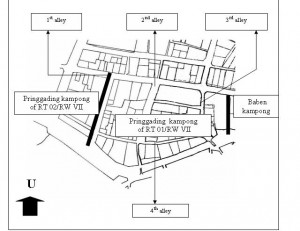A PRIVATE SPACE CONCEPT IN MIXED AREA ( SLUM-SQUATTER )
Case Study : Pringgading kampong of RT 01/RW VII
Kelurahan Setabelan, Kecamatan Banjarsari Surakarta
Departement of Architecture, Faculty of Engineering, Sebelas Maret University
Jalan Ir.Sutami no. 36 A, Surakarta, Middle of Java, INDONESIA
Telp ( 0271) 647069, Fax (0271) 643666,
Office email : arsitek@uns.ac.id and Personal email: dyah_pradnya@yahoo.com
ABSTRACT
Pringgading kampong of RT 01/RW VII is an area of a crowded settlement that is located at North side of the Pepe’s river bank in Surakarta. The houses are crowded and dirty. There are shacks between houses in Pringgading kampong of RT 01/RW VII. Some houses are in bad condition, but on majority, the houses are in good condition. The majority of inhabitants in Pringgading kampong of RT 01/RW VII was in low-income economic condition. This house condition at Pringgading kampong of RT 01/RW VII there is no clear separation between people who live in the slums and squatters. Most inhabitants got their income from selling of food and snacks and some do other works , such as : pedicap drivers, seamstresses and food vendors . The inhabitants work at the alley at the Pepe’s river bank in Pringgading kampong of RT 01/RW VII. Based on activities done there, some alleys had change their function from a street facility to a working area. The houses are two and one storey houses. In 2 storey houses, the bedrooms are upstairs while in storey houses. The inhabitants used bunk beds, placed in a private space.
This research was done using Naturalistic Qualitative method for 8 months. Sampling was used as the unit of exploration and the analysis consisted of 45 houses that located at the 4th alley of the Pepe’s river bank. For observation, the researcher always explored every data and took information from some sources. The researcher collected data using Purposive Sampling technique, Snowball Sampling technique dan Cross Sectional system.
The result of this research showed that, generally, low-income inhabitants in Pringgading kampong of RT 01/RW VII were always need of private spaces than working places. Low-income inhabitants made private space as a special area. Also the condition of private spaces were not influenced by and separated from of working areas .
Keywords : alley, daily activities, private spaces
1.Introduction
Pringgading kampong is an area of a crowded settlement located on the North side of the Pepe’s river bank. This is the location of home industries; food and snacks. Cooking was important for the inhabitants of these alleys. Other inhabitants had other works, such as pedicap drivers, seamstresses and food vendors . Also, the inhabitants did their daily activities, such as,: washing, selling things , bathing, eating, interacting , gromming birds and drying chlotes along some alleys of the Pepe’s river bank. One area with special existence that was used as the research location was the area of RT 01/RW VII. The research location in Pringgading kampong of RT 01/ RW VII is shown on figure 1 :
Figure 1. Pringgading kampong Map
Source: Dinas Tata Kota Surakarta, 2005
Sample kinds of work and activities along some alleys of the Pepe’s river bank, RT 01/ RW VII, are shown on figures 2 :

Figures 2 .Sample kinds of work and activities at Pringgading kampong of RT01/RW VII
Source : Researcher’s analysis, 2008
Some alleys functioned not only as streets but also for working and socializing areas. Because the inhabitants worked at the alleys, the majority of their houses were always empty of activities. There houses acted only as temporary shelters functioned as sleeping and safekeeping quarters. This fact was shown on figures 3 :
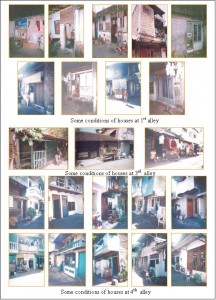
Figures 3.Some condition of houses at Pringgading kampong of RT 01/RW VII
Source : Researcher’s analysis, 2008
2. Houses and environment condition at Pringgading kampong
The houses were crowded and dirty. There were shacks between houses in Pringgading kampong. Some houses were in bad condition, but in majority, the houses were in good condition. The majority of the inhabitants in Pringgading kampong of RT 01/RW VII is in low-income economic condition. The condition of the houses were mixed between inhabitants who lived in slums and the squatters. The houses at Pringgading kampong of RT 01/RW VII were mainly two storey houses. The first floor functioned as a bussiness working area while the second floor functioned as sleeping and safekeeping quarters. The constructions were strong and their a façades were attractive. However, although the constructions of the houses were strong, some houses had very simple building materials, consisted of wood remnants, plastics, and iron sheetings. Moreover, the arrangement and the houses environment depended on each inhabitants activities. The trash were usually thrown away into the dump but sometimes the inhabitants threw the trash away the Pepe’s river. Some alleys were always clean so person could pass easily. Communal sanitation facilities in Pringgading kampong were used together by the inhabitants.
3.Discussion
A.The Position of the bedroom
The bedroom was a separated area, different from daily activities area. Every morning, the condition of the bedroom was not only clean and neat but also silent and empty from anybody and activity. Inhabitants were rarely in the house. They were more often at open spaces in front of their houses. In the morning, the inhabitants did their activities on the first floor and at along some alleys of the Pepe’s river bank. Meanwhile every time they needed a rest, the bedroom became important, functioned as a private space. Almost every night, the bedroom became silent and empty. The inhabitants worked, involved in cooking activities. The physical condition of bedrooms were mainly simple. The contained a mattress, without a bed. The mattress was placed on the plastic and slepping mat, which covered the floor made of wood remnants. The4re were also a wardrobe, some books, a television, a radio, some family photographs on the wall and clothes either dry or wet. There weren’t any bag, wallet , or other personal things inside the bedroom. The condition of the bedroom did not reflect the low-income level of the inhabitants. A two storey houses always had a bedroom upstair, meanwhile a one storey houses always had a bedroom on the corner of the house. Too keep their house clean, the inhabitants put a door mat and placed shoes out side their houses. The location of the bedroom are shown on figures 4 :
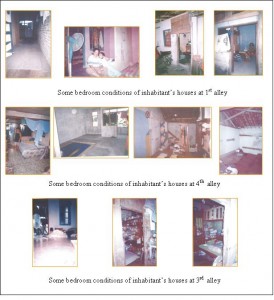
Figures 4. Some bedroom conditions of inhabitant’s houses
at Pringgading kampong of RT 01/RW VII
Source : Researcher’s analysis, 2008
Cleanness and neatness factors were applied on majority of the bedrooms. Conciousness about cleanness and neatness factors were deeply understood by the inhabitants at Pringgading kampong of RT 01/RW VII. The position of a bedroom was as a private space, a special place separated from their daily activities. Cleanness and neatness factors had became stimulant factors of economic situation when the inhabitants of Pringgading kampong enjoyed their lives.
B.Neighborhood connection
The inhabitants of Pringgading kampong of RT 01/RW VII had kinship other inhabitants at 1st ,2nd ,3rd and 4th alleys. They had powerful mental bonds. This familial mental bond influenced their relation with their neighbor and caused free and open condition. On the alley, a number of men often showed naked to the waist while women often showed with only a towel covered their bodies. Houses lining along some alleys of the Pepe’s river bank felt more like one room or one side of a mansion for the inhabitants. Every morning, the inhabitants interacted in front of their houses while they work. Meanwhile every afternoon, the intensity of interaction lessened because they prepared to cook or to do other work. In the evening, the inhabitants did not meet often because they were very busy cutting vegetables, cooking, and selling food. There was a close social interaction and freedom, like a familial mental bonds of real family. Nevertheless when connected to the economic factors, a boundary was built. There wasa phenomena of static interaction and activity at the same place. The widht of each inhabitant economic space was limited to the widht of his/her house,otherwise he/she would bother his/her neighbor’s space. A stranger’s or inhabitants position on a space of interaction would influence behavior of the inhabitant, and space of interaction became a closed characteristic too. Some alleys changed their functions, became part of a house functioned as a working area. The inhabitants never borrowed cooking appliances from others and they never lost those appliances too, because they were very protective, always busy cooking, and there were always somebody awoke doing and watching things. The placement of things and some activities had created special condition in each alley. The condition is shown on figures 5 :
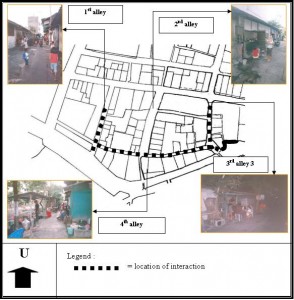
Figure 5. Location of interaction at Pringgading kampong of RT 01/RW VII
Source : Researcher’s analysis, 2008
C.The working place
Inhabitants at Pringgading kampong of RT 01/RW VII used some alleys in front of their houses along the Pepe’s river bank as working places. There was no boundary between the working place and a place to go through. Strangers could pass along some alleys but some working activities, inhabitant’s positions, cooking appliances, and housing equipments in front of the house became hindrance. The working place was their terrace up across the alley. The widht of their working places was the width of the alley in front of their houses. The working activities and the practice of placing things at the alley created binding situation.This condition became the base of transparent space form on every alley that would be felt by strangers when they passed in some alleys river bank namely 1st ,2nd ,3rd and 4th alleys. Moreover, eye contact between a stranger and the inhabitant became a boundary factor too. A transparent space phenomena was a boundary form of an alley and became closed a characteristic. This condition is shown on figure 6 :
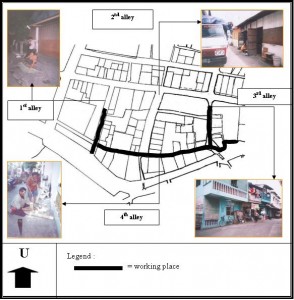
Figure 6. Working place at Pringgading kampong of RT 01/RW VII
Source : Researcher’s analysis, 2008
4.Conclusion
The result of this research showed that, generally, low-income inhabitants in Pringgading kampong of RT 01/RW VII were always need of private spaces than working places. Low-income inhabitants made private space as a special area. Also the condition of private spaces were not influenced by and separated from of working areas .
5.Recommendation
• A kampong with special characteristics need to be safeguarded even made into a potential object of tourism in a city
• An evaluation schedule of maintenance must be applied on a kampong with special characteristics
• The potential ability of a kampong with special characteristics can develop citizen’s income in a city
• A private space in low-income society need to be maintenanced to prevent confusing situation
6.References
Bungin, Burhan.2003, Analisis Data Penelitian Kualitatif, PT.Raja Grafindo Persada, Jakarta
Hillier, Bill ; Hanson,Julienne.1984, The Social Logic of Space, Great Britain the Bath Press, Avon
Jackson, John Brinckerhoff, 1909, Discovering The Vernacular Landscape, Murray Printing Company, Westford, Mass
Lang, John T . 1987 , Creating Architectural Theory, Van Noostrad Reinhold,
Melbourne
Moleong, Lexy.J.1989, Metodologi Penelitian Kualitatif, PT.Remaja Rosdakarya, Bandung
Muhajir, Noeng.1989, Metodologi Penelitian Kualitatif, Rake Sarasin, Yogyakarta
Sommer, Robert, Sommer B, Barbara.1980. A Practical Guide to Behavioral Research, Clifford University Press
Tuan, Yi-Fu.1977, Space and Place, University of Minnesota Press, Minneapolis
Van de Ven, Cornelis.1995,Ruang dalam Arsitektur, PT.Gramedia Pustaka Utama, Jakarta
[1] Paper presented at the International Seminar on Sustainable Slum Upgrading in Urban Area organized by
ISAH Network in cooperation with CIB W110 , LPPM of Sebelas Maret University and Departement of
Architecture, Faculty of Engineering, Sebelas Maret University on April. 16, 2009
[1] Lecturer, Department of Architecture, Faculty of Engineering, Sebelas Maret University
